
This is one of the most popular anime series of all time, though hard-core otaku tend to look down on it. It attracted an enormous audience when it was first broadcast in Japan. Millions of Americans have watched a horribly dubbed version on the Cartoon Network, and dubbed versions in other languages have been broadcast in many other countries.
There are reasons for its popularity. This show has many of the attributes of greatness. However it also has a serious flaw which keeps me from giving it a wholehearted recommendation (but see the update below). Nevertheless I have a certain fondness for it. For one thing it was seeing it on the Cartoon Network that first got me interested in anime.
-
TitleInu Yasha (also spelled InuYasha or Inu-Yasha)
-
DemographicShounen
-
GenresHistorical Fantasy, Adventure, Horror, Romance
-
Contents167 episodes plus 4 movies
-
LanguagesJapanese with subtitles, English
-
Based onA manga by Rumiko Takahashi
-
DirectorsMasashi Ikeda (eps 1 to 44)
Yasunao Aoki (45+) -
Animation StudioSunrise
-
BroadcastYomiuri TV, 2000-2004
-
Region 1 PublisherVIZ
There is much to like about the series. The writing is clever and consistently entertaining. The characters are memorable. The artwork is good, often very beautiful. It includes some great music, including “Change the World”, the first season’s opening theme, and “Every Heart”, the haunting ending theme from the third season.
It has a compelling story line, an epic tale of magic and mayhem; of malice and cruelty; of grief and loss and bitterness and regret; of damnation and salvation; and also of indomitable courage and the redeeming power of friendship and love. The strength and optimism of the central characters makes the story seem exhilarating rather than depressing.
It was a very influential series. It established once and for all that a complex and satisfying fantasy universe can be created using only Japanese traditions and folklore. Previously most fantasies had relied mostly on Western magical traditions, with a few Japanese elements thrown in for local color.
So what is wrong with it? Mainly that it goes on and on and on and on and on and on and on without ever coming to a satisfactory conclusion. (The TV series closely followed the original manga storyline. When they caught up with the manga and thus had no more material to work with, they just stopped. The manga is still going on and seems to be in no hurry to finish.)
The individual episodes are very entertaining, but viewers are likely to eventually get frustrated with a story that has no real conclusion. It’s rather like starting The Lord of the Rings, only to find out that it ends somewhere in the middle of The Two Towers (except this series is much longer than any possible adaptation of LOTR.)
For those who are interested in the series, the first two seasons (episodes 1-54) are probably the best. The story unfolds at a measured but steady pace and there is a lot of character development. Things slow down a bit in the third season. After that things seem to run in circles; individual episodes tell interesting or amusing stories but the main story line never seems to get anywhere.
UPDATE: The second anime series Inuyasha the Final Act brings the story to a satisfactory conclusion, and in some ways justifies some of the material in the first series that seemed unnecessary.
-
Original TitleInuyasha Kanketsu-hen (Inuyasha the Final Act)
-
DemographicShounen
-
GenresHistorical Fantasy, Adventure, Horror, Romance
-
Contents26 Episodes
-
LanguagesJapanese with subtitles
-
Based onA manga by Rumiko Takahashi
-
DirectorYasunao Aoki
-
Series CompositionKatsuyuki Sumisawa
-
ScriptKatsuyuki Sumisawa
-
Animation StudioSunrise
-
BroadcastYomiuri TV, 2009-2010
-
Region 1 PublisherVIZ
-
Currently Streaming At
The second series doesn’t stand by itself. It makes no attempt to bring new viewers up to speed; someone who has not seen the original series will probably not understand who these people are, why they act as they do, and why the events we see are important.
While the original series sometimes seemed padded, the second series, which covers the final 21 volumes of the manga in 26 episodes, sometimes feels rushed. The first 2 episodes are quite frenetic, but after that it settles down to a more reasonable pace.
If you consider both series together as a single anime, the result is quite good, and I have accordingly revised the star rating upward. All things considered, this is probably my favorite shounen action-adventure series. The only reason it doesn’t get 5 stars is that at a total of 193 episodes I still think it is unreasonably long. Rumiko Takahashi is a talented storyteller, but she seems to have trouble keeping a long-form story under control.
Parental Advisory
This series includes some light comic episodes that could probably be enjoyed by the entire family, but the series as a whole is far too dark and violent for young children. Some ten year olds may be able to handle it, and most teenagers should be able to deal with it without difficulty.
Historical Background
The Warring States Period (sengoku jidai) was one of the most traumatic chapters in Japanese history, with consequences that continue to be felt today. Beginning in 1467 a series of civil wars destroyed the authority of the central government. The country was divided between various warlords, or daimyo, who constantly fought each other. Roving gangs of bandits, peasant uprisings and armed religious fanatics all added to the disorder. The appearance of European traders and missionaries, who introduced guns and disturbing new ideas, contributed to the general sense of chaos and unrest.
The civil wars ended only in 1600 when Ieyasu Tokugawa defeated the other warlords and united Japan under his own rule. He made himself Shogun and constructed a fortified capital in Edo (present-day Tokyo.) This was the beginning of the “Edo Period” or “Tokugawa Shogunate”, during which Japan enjoyed more than 250 years of peace and stability–though this came at a price.
The new government established a society with a rigid class hierarchy and a tradition of strict social conformity. Foreigners were banned from the country as a dangerous influence. Christianity and firearms were outlawed with draconian penalties. These measures may have provided stability but the resulting society was poorly equipped to deal with the challenges of a changing world.
DVD Information
So far 49 DVDs have been released in North America including episodes 1-148 of the TV series. Renting some of them is a reasonable option for anime fans who are interested in the series. Buying all of the DVDs is probably out of the question for all but the most fanatical and well-heeled fans.
The English dubs for most animes fall in a range from “mediocre” to “awful”. The dub for this series is at the low end of the range. The cast often seems to be under the impression that they are dubbing an episode of Scooby-Doo. I recommend sticking with the Japanese soundtrack and using subtitles. The Japanese cast is highly regarded, especially Kappei Yamaguchi as Inuyasha.
Translation Issues: Youkai
The subtitle translation is generally adequate but it suffers from an apparent desire to replace every Japanese word with an English equivalent, even when no equivalent English word exists. One case where this has particularly unfortunate results is the word youkai, which is translated as “demon”. This is justifiable in a narrow sense since most dictionaries give “demon” or “monster” as possible translations, but it is a poor choice in the context of this story.
For most English-speakers the word “demon” implies a being that is intrinsically evil. The youkai of this story are more like embodiments of the forces of wild, untamed Nature. They are dangerous and often hostile to humans, but not necessarily evil. The category includes some fairly conventional monsters as well as powerful animals that can assume human form.
This series has a strong theme of racial tolerance (which is quite unusual in a Japanese TV series.) The youkai are used a metaphor for other races and cultures. Calling them “demons” in the translation creates a decidedly mixed message.
The Movies
The four theatrical movies are all available on DVD. They are closely tied to the TV series and will probably not make much sense to those who have not seen it. None of them contribute anything essential to the story.
Inuyasha the Movie: Affections Touching Across Time takes place shortly after episode 54, and recapitulates many of the themes from the first two seasons.
Inuyasha the Movie 2: The Castle Beyond the Looking Glass takes place sometime after episode 81. It is basically a takeoff on a tenth century Japanese story called The Tale of the Bamboo Cutter.
InuYasha the Movie 3: Swords of an Honorable Ruler is the most interesting of the movies, as well as the darkest. It takes place sometime after episode 132 and includes background information that is not presented anywhere else.
Inuyasha the Movie 4: Fire on the Mystic Island takes place after the end of the TV series. It is a rather confusing and forgettable story about a mysterious island that appears once every 50 years.
Characters and Premise
Prologue: About 550 Years Ago
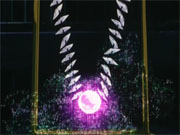 The Shikon no Tama (Jewel of the Four Souls) is one of those magical items that everyone wants but nobody should be allowed to have. It has the ability to increase anyone’s power. In the hands of a sufficiently powerful individual it could be used to rule the world. However it is delicately balanced between good and evil. Any use of it for selfish purposes will tip it to the side of evil with disastrous consequences.
The Shikon no Tama (Jewel of the Four Souls) is one of those magical items that everyone wants but nobody should be allowed to have. It has the ability to increase anyone’s power. In the hands of a sufficiently powerful individual it could be used to rule the world. However it is delicately balanced between good and evil. Any use of it for selfish purposes will tip it to the side of evil with disastrous consequences.
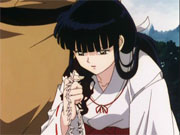 Kikyou is a miko who tends a Shinto shrine near Edo. Because of her great spiritual and magical powers, she has been entrusted with the task of safeguarding the Jewel. Now she is beset by increasing numbers of youkai and evil humans who want to seize it for themselves.
Kikyou is a miko who tends a Shinto shrine near Edo. Because of her great spiritual and magical powers, she has been entrusted with the task of safeguarding the Jewel. Now she is beset by increasing numbers of youkai and evil humans who want to seize it for themselves.
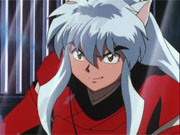 Inuyasha is a hanyou, half human and half youkai, and as a result has spent his life being shunned and persecuted by both humans and youkai. His mother was a human noblewoman; his father was a great youkai leader referred to only as “The Commander of the Dogs.” He wants to use the power of the Jewel to become a full youkai like his father.
Inuyasha is a hanyou, half human and half youkai, and as a result has spent his life being shunned and persecuted by both humans and youkai. His mother was a human noblewoman; his father was a great youkai leader referred to only as “The Commander of the Dogs.” He wants to use the power of the Jewel to become a full youkai like his father.
Probably because he was cast out of human society at a very young age, Inuyasha’s manners leave much to be desired. He is vulgar, rude, insensitive, bad-tempered and violent.
Characters from Present-Day Tokyo
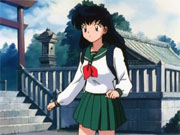 Kagome Higurashi is a 15 year old girl who has grown up in an ancient Shinto shrine, listening to her grandfather’s tales of old legends and ancient traditions. However she is a modern girl with little interest in such things. Soon she may wish that she had paid more attention.
Kagome Higurashi is a 15 year old girl who has grown up in an ancient Shinto shrine, listening to her grandfather’s tales of old legends and ancient traditions. However she is a modern girl with little interest in such things. Soon she may wish that she had paid more attention.
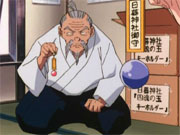 Kagome’s grandfather is an elderly shrine-keeper who loves the old stories, but it is not clear if he really believes them. He is basically a lovable old fraud who can sometimes be seen trying to sell worthless charms and fake relics to the shrine’s visitors.
Kagome’s grandfather is an elderly shrine-keeper who loves the old stories, but it is not clear if he really believes them. He is basically a lovable old fraud who can sometimes be seen trying to sell worthless charms and fake relics to the shrine’s visitors.
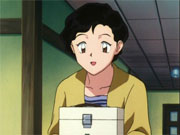 Kagome’s mother is cheerful and supportive. Few mothers would be so sanguine about having a young daughter go off on dangerous adventures.
Kagome’s mother is cheerful and supportive. Few mothers would be so sanguine about having a young daughter go off on dangerous adventures.
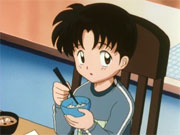 Souta Higurashi is Kagome’s admiring younger brother.
Souta Higurashi is Kagome’s admiring younger brother.
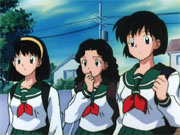 Eri, Ayumi and Yuka are Kagome’s closest friends at school.
Eri, Ayumi and Yuka are Kagome’s closest friends at school.
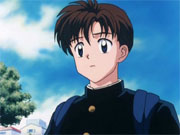 Houjou is another classmate. He is something of a health-food nut and is infatuated with Kagome.
Houjou is another classmate. He is something of a health-food nut and is infatuated with Kagome.
The Main Story Line: About 500 Years Ago
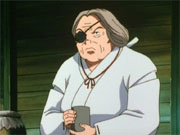 Kaede is Kikyou’s younger sister. Now grown old, she manages what is left of Kikyou’s shrine, which seems to have fallen on hard times.
Kaede is Kikyou’s younger sister. Now grown old, she manages what is left of Kikyou’s shrine, which seems to have fallen on hard times.
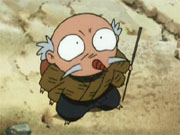 Myouga is a youkai flea, a former vassal of Inuyasha’s father. He is a coward, but he is very old and knowledgeable and is often a source of useful information.
Myouga is a youkai flea, a former vassal of Inuyasha’s father. He is a coward, but he is very old and knowledgeable and is often a source of useful information.
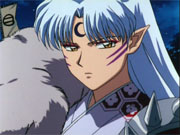 Inuyasha’s half brother Sesshoumaru is proud, arrogant and anti-social. Strong and talented, he might have become a great youkai leader like his father, were it not for the fact that he cannot tolerate the company of most youkai. He hates humans and feels that his father dishonored the family by falling in love with a human woman. He hates Inuyasha as a confirmation of the family’s disgrace.
Inuyasha’s half brother Sesshoumaru is proud, arrogant and anti-social. Strong and talented, he might have become a great youkai leader like his father, were it not for the fact that he cannot tolerate the company of most youkai. He hates humans and feels that his father dishonored the family by falling in love with a human woman. He hates Inuyasha as a confirmation of the family’s disgrace.
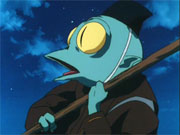 Jaken is Sesshoumaru’s faithful companion. He is a obsequious little twerp, but he amuses Sesshoumaru, who seems to be fond of him though he tries not to show it.
Jaken is Sesshoumaru’s faithful companion. He is a obsequious little twerp, but he amuses Sesshoumaru, who seems to be fond of him though he tries not to show it.
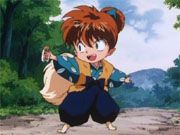 Shippou is a orphaned fox pup. Traditionally foxes can take the form of humans in order to commit all sorts of mischief, but he seems to be too young to have fully mastered the technique. Somewhat bratty but very cute, he usually plays a central role in the occasional comic relief episodes.
Shippou is a orphaned fox pup. Traditionally foxes can take the form of humans in order to commit all sorts of mischief, but he seems to be too young to have fully mastered the technique. Somewhat bratty but very cute, he usually plays a central role in the occasional comic relief episodes.
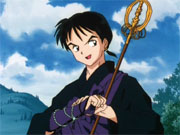 Miroku is an itinerant Buddhist monk. He is a lecherous con-artist, but he has some good points. He has strong spiritual powers and is a competent exorcist, though he does have a bad habit of charging people for exorcising non-existent evil spirits. He is good at unarmed combat, knows a great deal of magical lore, and is loyal to his friends. He is cursed with the kazaana, a hole in the palm of his right hand that can suck up everything in the vicinity. Sometimes he uses this as a weapon.
Miroku is an itinerant Buddhist monk. He is a lecherous con-artist, but he has some good points. He has strong spiritual powers and is a competent exorcist, though he does have a bad habit of charging people for exorcising non-existent evil spirits. He is good at unarmed combat, knows a great deal of magical lore, and is loyal to his friends. He is cursed with the kazaana, a hole in the palm of his right hand that can suck up everything in the vicinity. Sometimes he uses this as a weapon.
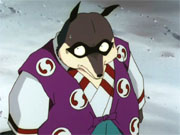 Miroku’s friend Hachiemon (“Hachi” for short) is a tanuki or raccoon dog. These are Asian animals related to foxes, but with markings similar to a North American raccoon. Like foxes they are shape-shifting trouble-makers, but they are also considered symbols of good luck.
Miroku’s friend Hachiemon (“Hachi” for short) is a tanuki or raccoon dog. These are Asian animals related to foxes, but with markings similar to a North American raccoon. Like foxes they are shape-shifting trouble-makers, but they are also considered symbols of good luck.
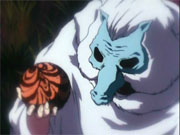 Naraku is one of the most chilling villains ever created. He doesn’t particularly care about killing people; he wants to destroy their souls. He can sometimes force himself to appear friendly and charming, but his inner malice is so great that poison runs in his veins. Literally.
Naraku is one of the most chilling villains ever created. He doesn’t particularly care about killing people; he wants to destroy their souls. He can sometimes force himself to appear friendly and charming, but his inner malice is so great that poison runs in his veins. Literally.
Worst of all, he is much too smart. He doesn’t just keep one step ahead of our heroes; he repeatedly laps them and attacks from behind.
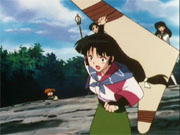
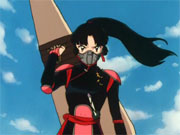 Sango is a youkai taijiya (youkai exterminator). Over many generations her people have accumulated a great deal of lore about youkai, and they use this knowledge, combined with advanced martial arts skills, to kill youkai who threaten humans.
Sango is a youkai taijiya (youkai exterminator). Over many generations her people have accumulated a great deal of lore about youkai, and they use this knowledge, combined with advanced martial arts skills, to kill youkai who threaten humans.
Sango is very strong, resourceful and quick-witted. She carries many weapons, the most powerful of which is Hiraikotsu, a giant boomerang made from youkai bones.
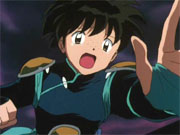 Kohaku is Sango’s younger brother. Like Sango he has been trained from an early age to become a youkai taijiya, but he may lack the necessary mental toughness to succeed in such a dangerous occupation.
Kohaku is Sango’s younger brother. Like Sango he has been trained from an early age to become a youkai taijiya, but he may lack the necessary mental toughness to succeed in such a dangerous occupation.
 Sango’s pet Kirara is a nekomata or two-tailed cat. As such she would be expected to have magic powers. She can grow to the size of a car and fly through the air.
Sango’s pet Kirara is a nekomata or two-tailed cat. As such she would be expected to have magic powers. She can grow to the size of a car and fly through the air.
 Toutousai is a youkai swordsmith, an old friend of Inuyasha’s father. He seems comical and ineffectual, but his skill at making magical weapons is unequaled.
Toutousai is a youkai swordsmith, an old friend of Inuyasha’s father. He seems comical and ineffectual, but his skill at making magical weapons is unequaled.
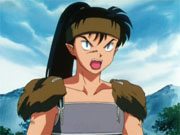 Kouga is the leader of a tribe of youkai wolves. He hates dogs but is more open-minded about human girls.
Kouga is the leader of a tribe of youkai wolves. He hates dogs but is more open-minded about human girls.
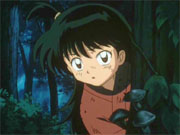 Rin is a little girl who was traumatized by seeing her family killed by bandits. Now she seems unable to trust any human.
Rin is a little girl who was traumatized by seeing her family killed by bandits. Now she seems unable to trust any human.
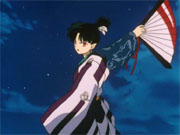 Kagura the Wind Sorceress is one of Naraku’s minions. She has the power to control the winds and reanimate dead bodies. Proud, cruel and ruthless, she actually hates Naraku and serves him unwillingly.
Kagura the Wind Sorceress is one of Naraku’s minions. She has the power to control the winds and reanimate dead bodies. Proud, cruel and ruthless, she actually hates Naraku and serves him unwillingly.
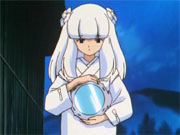 Kanna is another minion of Naraku. It is impossible to tell how she feels about Naraku, or indeed whether she has any feelings about anything. Her mirror gives her the power to steal people’s souls and observe distant events.
Kanna is another minion of Naraku. It is impossible to tell how she feels about Naraku, or indeed whether she has any feelings about anything. Her mirror gives her the power to steal people’s souls and observe distant events.
Links
Anime News Network entry.
Wikipedia article. (Spoilers!)
My own notes on Types of Magic Used in Inu Yasha. (Mild spoilers.)
My own notes on the ending. (Spoilers.)

